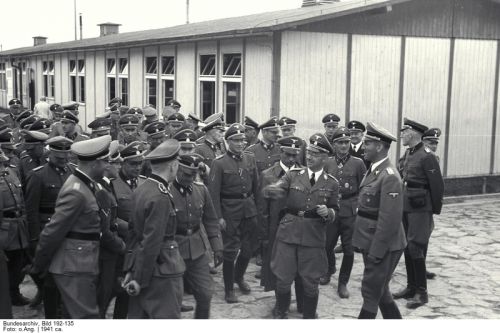Mauthausen
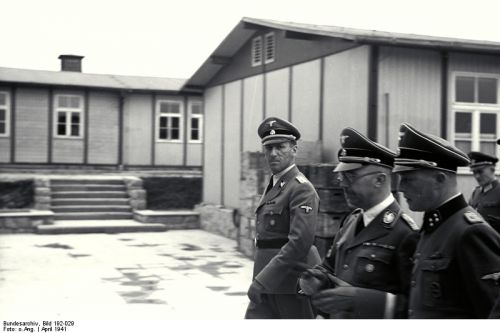
Mauthausen - Kaltenbrunner, Himmler and Camp Commandant Franz Ziereis - April 1941 (Bundesarchiv)
Mauthausen Concentration Camp was established shortly after the Nazi Anschluss of Austria, in March 1938, near an abandoned stone quarry approximately three miles from the market town of Mauthausen, in Upper Austria. On May 16, 1938, work began in the quarry, initially employing thirty civilian workers. The first prisoners were brought to the camp on August 8, 1938, and were put to work in the construction of the camp and at the quarry.
Most of the prisoners brought to Mauthausen in the first year of its existence were criminal offenders and the rest were classed as 'asocial elements.' Almost all were transferred from Dachau Concentration Camp. The first consignment was accompanied by 88 SS guards also from Dachau, and were members of the SS-Totenkopfverbande. In 1938, a total of 1,100 prisoners arrived. The first political prisoners also came from Dachau Concentration Camp, and they arrived in Mauthausen during May 1939. Soon afterwards groups of political prisoners were brought from prisons in Czechoslovakia. Late in September 1939, the 'Punishment Squad' from Dachau arrived at the camp. By December 1939, there were 2,666 prisoners, almost all Germans, interned in Mauthausen. During the course of 1940, approximately 11,000 new prisoners were recorded in the concentration camp's 'book of numbers,' which served to record each new prisoner, together with their camp number.
German prisoners from the Sachsenhausen Concentration Camp, 1032 and from Buchenwald Concentration Camp, 300, were all transferred to the first sub-camp of the main camp, called Gusen. A further three consignments to Mauthausen brought an unknown number of Spanish republicans who had fled Spain and General Franco's regime, and had been caught in France, after its defeat by Germany. The number of prisoners during 1940, reached 3,833. Seven consignments of Spanish arrived during 1941, and their number in the camp reached 7,241. Many Jews were also sent together with groups of Czech prisoners. On May 12, 1940, the first transport of Jews from the Netherlands arrived and on October 20, 1941, an initial transport of 4,205 Soviet Prisoners -of-War arrived in Mauthausen, though approximately 2,000 of these were transferred to the Gusen sub-camp. On January 2, 1941, Reinhard Heydrich, head of the RSHA in Berlin, published an edict that classified the concentration camps into categories, and Mauthausen was classed as a Category III, prisoners beyond correction. A few months later Heinrich Himmler visited Mauthausen during April 1941, along with a number of leading SS figures and Waffen-SS senior officers.
During 1941, Mauthausen received a total of 18,000 new prisoners. The mortality rate was high and the number of prisoners in Mauthausen and the sub-camp Gusen reached 11,135. In 1942, in addition to Czech, Dutch, Soviet and Yugoslav prisoners, deportees also arrived from Belgium, France, Greece and Luxembourg. A new category of prisoners, those in protective custody, were transferred from various prisons. A despatch of 218 such prisoners reached Mauthausen on November 26, 1942, from the Regensburg prison. Altogether 13,000 new prisoners came to the camp during 1942.
The stream of prisoners of different nationalities continued throughout 1943, during which 21,028 new prisoners were recorded, and only a small number of these were Jews. During 1943, 8,334 prisoners were entered in the records as having died at Mauthausen and Gusen, along with 147 Prisoners-of -War. In addition to these numbers many other victims were killed by order of the Gestapo immediately upon their arrival at the camp and did not pass through the normal registration procedures.
In 1944, the number of prisoners who reached Mauthausen Concentration Camp increased considerably - many new sub-camps were built and the new prisoners were sent to them. A record 65, 645 new prisoners were listed in the 'book of numbers.' The maximum prisoner population at any one time during 1944, was 114, 524. Beginning in May 1944, the camp received large transports of Jews from Auschwitz Concentration Camp, and four such transports in May and June 1944, brought a total of 7,500 prisoners. On August 10, 1944, a transport of 4589 Jewish prisoners came from the Plaszow Labour camp in Krakow. The final large transport in 1944, arrived in late September bringing 6,449 prisoners, of whom half were Jews. According to the camp records a total of 13,322 Jewish males and 504 Jewish females entered the camp during 1944. The number of Jews who died that year was 3,437.
One particular noteworthy transport arrived in Mauthausen on September 9, 1944, a group of thirty-nine Dutchmen, one American and seven Englishmen, all of them active in the anti-Nazi underground were brought to the camp. After spending the night inside the bunker they were driven, barefoot and in their underclothes, to the quarry, where the 186 steps were lined on both sides by SS and Kapo's swinging their cudgels and anticipating a spectacle. The forty-seven prisoners were loaded with stone slabs of up to sixty pounds in weight and then forced to run up the steps. The run was repeated again and again and the blows fell faster, as the exhausted prisoners stumbled on the uneven steps. One of the prisoners was a British Jew, Marcus Bloom, who had operated a clandestine radio in Nazi-occupied Europe. He was the first to fall, he was shot in the head at point-blank range.
On January 25, 1945, one of the death march transports from Auschwitz reached Mauthausen. Auschwitz and its complex of camps was being evacuated in the face of the advancing Soviet forces. In one week 9,000 prisoners of various nationalities arrived in the camp, the majority of them Jews. One of the deportees from Auschwitz, Yehuda Bakon later recalled how on the march, 'The children said - it is good that our parents were killed in the gas chambers. They did not have to undergo all this torturing and suffering - because we saw they shot everyone who fell.'
In April 1945, another large influx of Jewish prisoners, who had been deported from their native Hungary to camps along the Austrian-Hungarian border reached Mauthausen. A total of 24,793 new arrivals were recorded in the camps books for 1945. The number of the last prisoner 139,157 was allocated on May 3, 1945, two days before the camp was liberated by American forces.
It is fitting that we now provide a physical description of the camp, the SS personnel, the prisoners and some more information about the history of Mauthausen Concentration Camp:
The camp area was divided into 3 sections. The Prison Camp, the Command Area and the SS Accommodation
The prison camp occupied the main part of the camp area and had 3 sectors:
Camp Number 1 was the residential camp, with 20 wooden huts, 4 of these were quarantine huts, where the new prisoners lived for three weeks, after which they were transferred to other sections of the camp. The last hut Number 20, was separated by a stone wall and initially housed the Soviet Prisoners of War.
Camp Number 2 was the workshops area, contained 4 huts, and from early 1944, this was also a quarantine area.
Camp Number 3 was built in the spring of 1944, and initially contained 6 huts. Beginning in the summer of 1944, the sick and debilitated prisoners were transferred here prior to being killed.
Each hut was designed to hold 300 prisoners, but in most instances double that number and even more were packed into them. Opposite the main gate was the Appelplatz, the roll-call square, where the prisoners had to stand for the morning and evening roll-call, and on occasions where prisoners were taken to be killed, in the presence of the whole camp.
On one side of the Appelplatz were three stone buildings. Two were used for the camp services - kitchens, showers and laundry. The third housed the camp bunker and the gas chamber disguised as a shower. Beneath the bunker was the crematorium - in a nearby cell prisoners were shot. Outside the camp enclosure was the 'Russian Camp' which was converted into the camp's hospital in the spring of 1943.
Approximately a month before the liberation of the camp in April 1945, a tented camp was set up outside the camp enclosure, with 14 large tents. It was designated for Hungarian Jews who had been brought from labour camps along the Austrian-Hungarian border and for Jews from the entire network of Mauthausen's sub-camps to stay in, until they were taken to Gunskirchen camp. The entire Mauthausen camp area covered approximately 37 acres.
The first commandant of the Mauthausen Concentration Camp was SS-
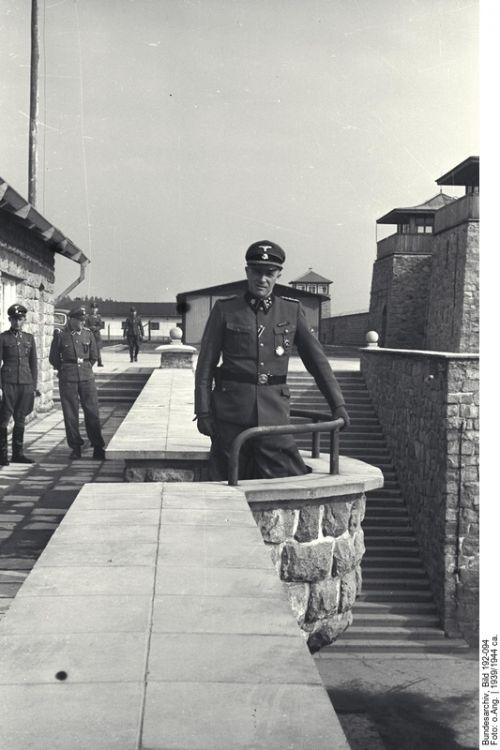
Franz Ziereis - Camp Commandant at Mauthausen (Bundesarchiv)
There were seven SS Officers and heads of divisions that served under him. His deputy and the Commandant of the prison camp was SS-Hauptsturmführer Georg Bachmayer, who had two deputies. Beneath them were the Rapportführer the recording officer, the labour service officer and the officer responsible for general administration work as well as block officers and labour gang officers.
On September 3, 1944, there were 91 SS-Blockführers and Kommandoführers in Mauthausen. The camp's Political Department was headed by SS- Hauptsturmführer Karl Schulz, who was in command of 19 NCO's. The camp guard units belonged to the Mauthausen SS-Totenkopfverbande.
Most of the prisoners in Mauthausen holding supervisory and other posts were criminal offenders and the camp authorities encouraged them to treat the rank and file prisoners harshly. These Kapo's had complete control over the lives of the prisoners under their command. The principal positions held by prisoners were those of Camp Elder, and his deputies and camp registrar. The work in the camp was supervised by the Kapo's and the blocks were under the authority of the block elder, the block registrar and the room elder. All of these people in these posts enjoyed a large number of privileges.
The Poles were the largest national group at Mauthausen, and the first Polish prisoners arrived on March 9, 1940. The camp's record of the dead lists 30,203 Poles, including many Polish Jews. Altogether there were nearly 50,000 Poles within Mauthausen and its sub-camps. Until the spring of 1941, only a few Jews arrived at Mauthausen and most of these died within a short space of time, due to the harsh conditions working in the quarry and from maltreatment. During 1941, larger transports of Jews began arriving.
Groups of Czech prisoners started to arrive in Mauthausen during 1939, and after the assassination in Prague of Reinhard Heydrich, the Deputy Protector, of Bohemia and Moravia, who was gravely wounded in Prague, when Josef Gabcik and Jan Kubis ambushed his car. Heydrich died of his wounds sustained by the grenade attack on June 4, 1942. Two hundred and fifty-three Czech nationals were brought to Mauthausen and killed. The women among them were taken in groups to the gas chamber. Most of the Czech prisoners were murdered in the three months, following Heydrich's assassination.
A year earlier on February 19, 1941, a German patrol in Amsterdam entered a tavern run by a Jewish refugee from Germany, Ernst Cahn. In the tavern a protective device which Cahn had installed, an ammonia flash, went off by accident, spraying the Germans with ammonia. Cahn was arrested immediately and three days later as a reprisal for his 'act of resistance' the SS raided the Jewish quarter of Amsterdam and seized 400 Jews, most of them were young men. They subjected them to beatings and abuse and then on February 27, 1941, 390 of them were deported to Buchenwald Concentration Camp, and then 389 of them were transferred to Mauthausen. Of this number 151 men of this group were among the early Jewish victims of Nazi gassing experiments at Schloss Hartheim Euthanasia institute near Linz.
One man Max Nebig survived at Buchenwald by volunteering for a human-guinea-pig operation, after which he was hidden in the TB ward at Buchenwald till the end of the war. To protest against the raids by the Germans against the Jews of Amsterdam, the Dutch Union of Dock Workers organised a General strike on February 25, 1941, in Amsterdam.
At Mauthausen the Dutch Jews were all put to work in the stone quarry, hauling massive blocks of stone up the steep incline. As they climbed the 186 steps they were whipped and beaten. On the third day, after their arrival the camp guards began machine-gunning the Dutch Jews, climbing on the steps. On the fourth day, some ten young Jews linked hands and jumped to their deaths. The Germans referred to those that had jumped as 'parachutists.' In order to prevent a recurrence of this collective suicide, the remaining prisoners were placed under the charge of two particularly sadistic guards, one known as the 'blonde fraulein,' the other as 'Hans the killer.' By the autumn, there were no survivors.
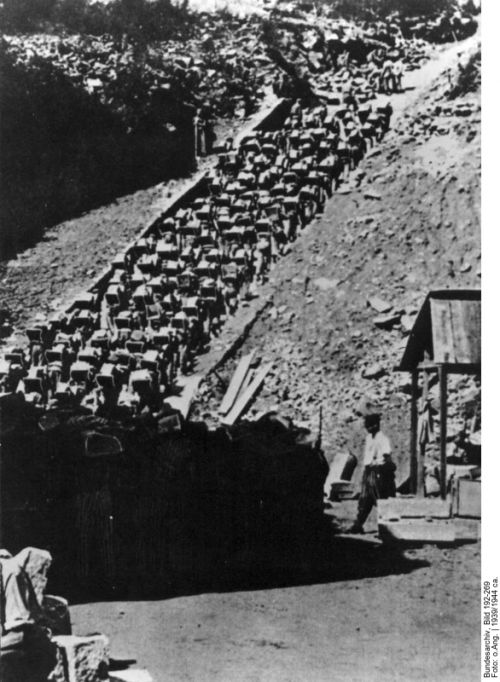
Mauthausen - The infamous steps at the Quarry (Bundesarchiv)
On May 3, 1945, the guarding of the camp was handed over to a police unit from Vienna, on the following day work ceased and the SS officers left the camp. That same day the officer in charge of the Bunker killed all the prisoners employed in the crematorium and in the Bunker, with a single exception. The next day at 11:30 in the morning American army tanks entered Mauthausen and the camp was liberated on May 5, 1945.
The number of prisoners who passed through Mauthausen Concentration Camp is estimated at 199,404. It is estimated that 119,000 died, of whom 38,120 were Jews. This number includes the victims sent from Mauthausen and its sub-camps to the nearby T4 Institute at Hartheim, which was part of the euthanasia programme. From August 1941, to October 1942, and from April 1944, to the end of that year, sick and debilitated prisoners, including Jews, were sent to Hartheim Castle in Alkoven, to be killed in its gas chamber.
The suffering of the Mauthausen inmates have been expressed by the Greek composer Mikis Theodorakis's 'Ballard of Mauthausen,' based on a work by the Greek Jewish poet Jacob Kambanelis. We leave the final say on Mauthausen to one of its most famous prisoners, Simon Wiesenthal, who recalled the liberation. He weighed only 110 pounds laying in Hut B of the so-called 'Death Block' where those unfit to work were left to die. On the morning of May 5, 1945, he staggered outside - 'I don't know how I managed to get up and walk- to meet the first American tank.'
Photographic Record of Heinrich Himmler's Visit to Mauthausen in April 1941
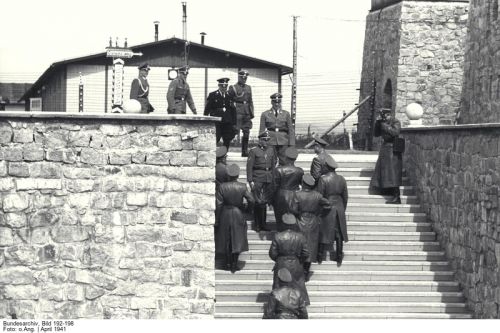

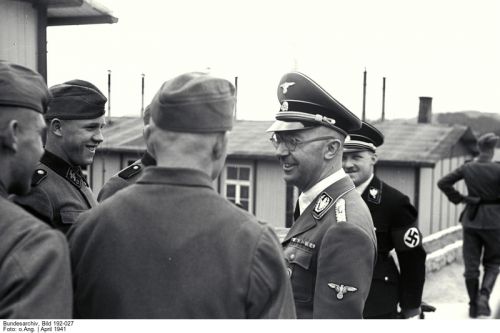
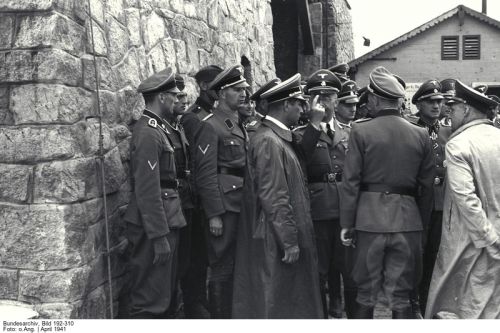
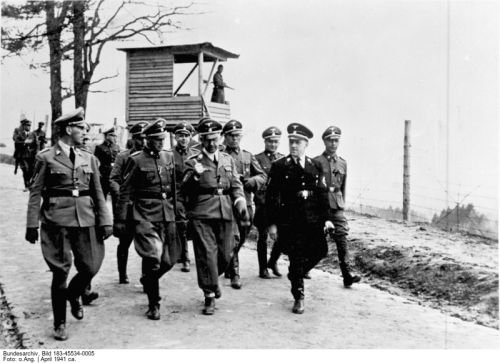
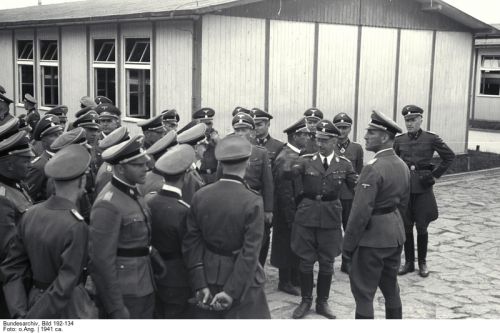

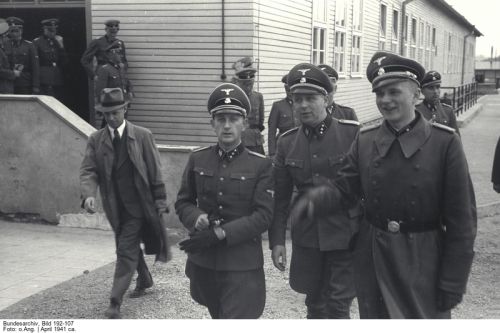
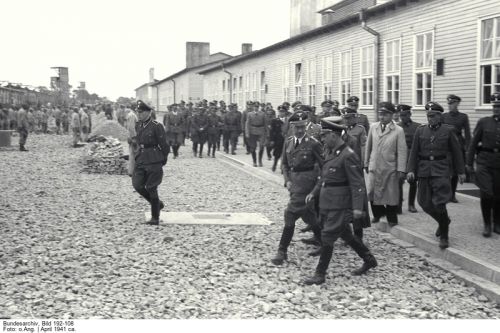
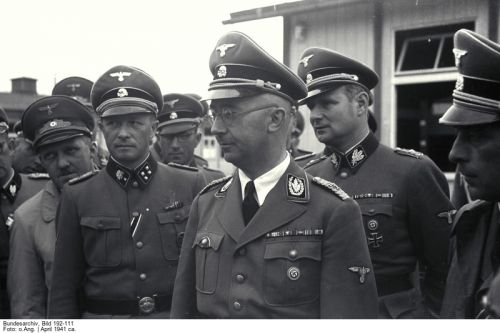
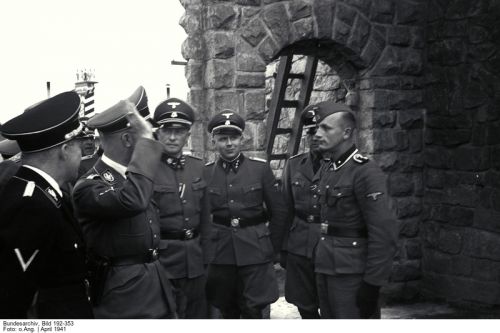
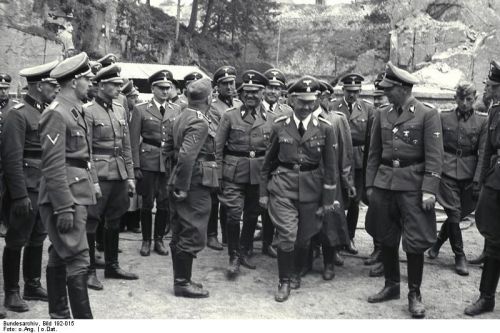
Photographs of Mauthausen and Gusen

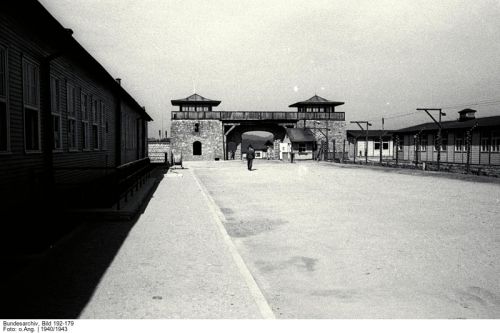
Mauthausen Appelplatz and Camp Entrance
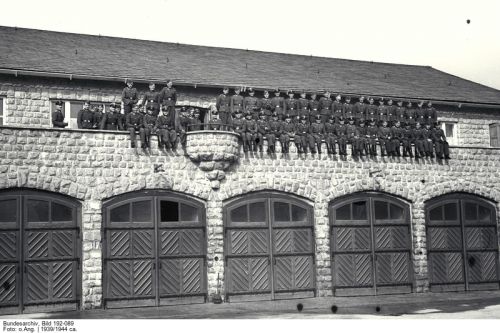
SS Staff pose on top of the garages

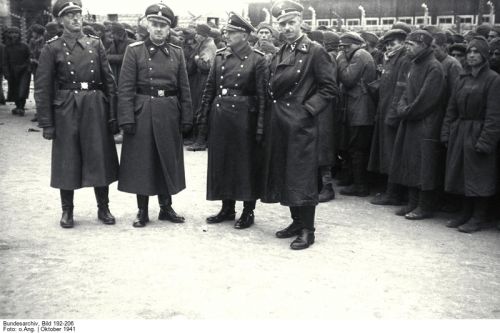
Gusen -SS Officers standing by Soviet Prisoners of War
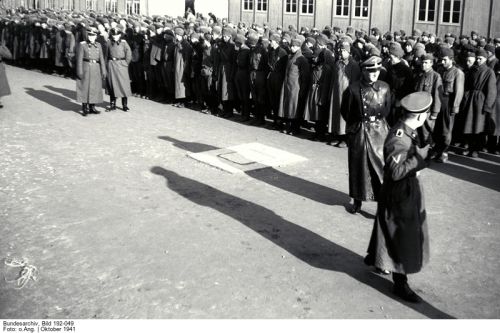
Gusen -Roll Call
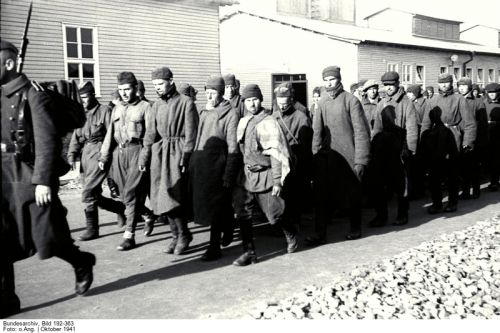
Soviet Prisoners of War
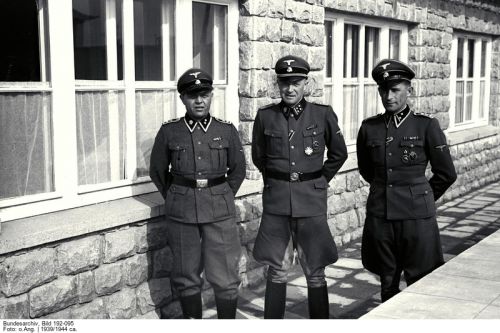
Sources
www. Holocaustresearchproject.org - online resource
French L. Maclean, The Camp Men, Schiffer Publishing Ltd 1991
Deborah Slier and Ian Shine, Hidden Letters, Star Bright Books Inc New York 2008
G. Reitlinger, The Final Solution, Vallentine Mitchell and Co London 1953
Wally de Lang, De razzia's van 22 and 23 Februari 1941 in Amsterdam, Atlas Contact 2021
Photographs - Bundesarchiv
Thanks to Lukasz Biedka
© Holocaust Historical Society March 21, 2022


